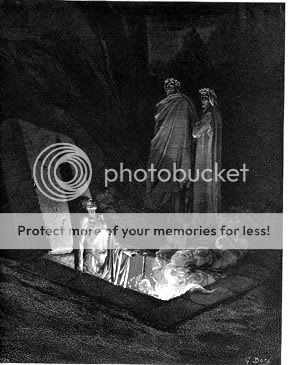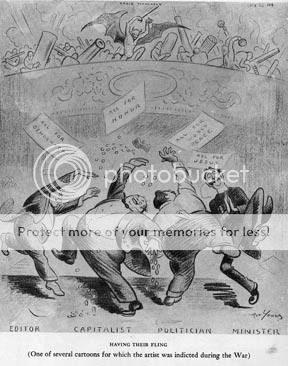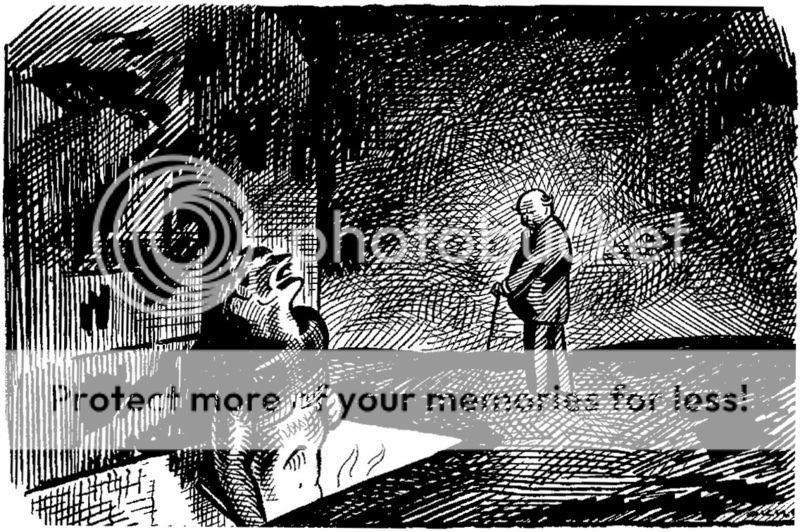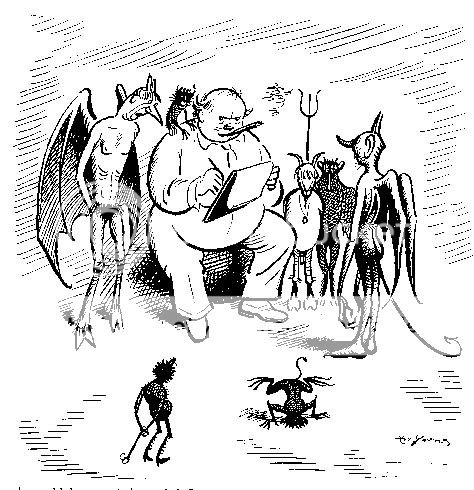I’m reprinting here the essay on socialist cartoonist Art Young which ran in TCJ 273. I lack the technical expertise for footnote capabilities, so the relevent source info is sprinkled throughout rather than referenced with tiny numbers. I’ve also edited the ending a little.
When this essay ran, it accompanied a gallery of Art Young images. I have put some of his drawings here; hope to get more of them up as the week goes on.
In any case, here’s the essay.
Building a Better Abyss
Hell is like Shakespeare: every generation invents its own. No surprise then that Art Young, who was born just after the Civil War and died in the middle of World War II, lived long enough to create several.
Young’s interest in the nether world started early. As an adolescent art prodigy in small-town Wisconsin, he got ahold of and devoured the edition of Dante’s Inferno illustrated by Dore. It was, he later recalled,“ the first book to give me a real thrill.” That initial impression was lasting: Young went on to study art in Chicago, New York, and Paris, and became something of an expert on the history of illustration, but his enthusiasm for Dore never wavered. “[I] counted him the greatest artist of his time,” he said. “I estimated the gift of imagination in all of the arts as supreme. And Dore had it.” [Art Young, Art Young: His Life and Times, John Nicholas Beffel, ed., New York: Sheridan House, 1939, pp. 52, 133.)
Young’s first book was a direct tribute to his hero. Hell Up to Date is what the title says — a trip through a modern Inferno, circa 1892, sprinkled with illustrations influenced by Dore’s woodcuts. At the time of writing it, Young was in his mid-20s, and clearly going places. His cartoons were selling briskly in Chicago, and he was making friends and connections among both artists and newspapermen. He suffered a chastening setback in Paris, when he contracted a case of pleurisy which almost killed him. But even while painfully recuperating at his parents home, he had every reason to be excited about his future.
Thus, Young’s book is a hodgepodge. On the one hand, he faithfully imitates many of Dore’s tropes: dramatic shading and composition, detailed draftsmanship, panels cluttered with figures, and long perspectives to suggest vast underground spaces. Yet, where Dore’s goal was to overawe, Young’s first version of Hell must be one of the least histrionic on record. Feeling that Dante and Dore were “too serious about Hell,” he created an Inferno which is basically an extended series of gag cartoons — Thomas Nast caricatures trapped in Renaissance paintings. Young’s sinners tend to look annoyed or constipated rather than tormented, and the elaborate punishments he devises for contemporary pests are clever rather than gruesome. Unfeeling editors are consigned to red-hot wastebaskets, unattentive husbands are dressed in drag, and hobos are forced to bathe. The general tone of comfortable irony is embodied in the narrator, R. Palasco Drant. A wise-cracking city newspaperman, Drant is so filled with spunk and get-up-and-go that he greets the Ancient Enemy with a jovial “Howdy, Sate!” and then promises to give the Inferno a PR boost via “six columns” in a major metropolitan daily. (Art Young, On My Way: Being the Book of Art Young in Text and Pictures, New York: Horace Liveright, 1928, p.19; Art Young, Hell Up To Date: The Reckless Journey of R. Palasco Drant, Newspaper Correspondent, Through the Infernal Regions, as Reported by Himself. Chicago: The Schulte Publishing Company, 1892.]

The Renaissance is dead but not buried: one of Dore’s illustrations for The Inferno.
In his introduction, Young notes that his purpose in writing the book was “to learn if the region of fire was the same as of old, or whether it kept pace with the triumphal march of progress.” He claims that it has and that Hell is “now run on the broad, American plan.” But this is a little disingenuous. Young’s Hell has an agnostic sense of humor; it has modern sinners; and it is mechanized — with trolley-cars, pneumatic tubes, and the other technological paraphernalia of the late nineteenth century. Yet, for all these differences, Drant’s Hell and Dante’s Hell work in much the same way. Those who have sinned on Earth are cast into the Pit where they suffer retribution. Hades is a place where wrongs are righted and evil-doers punished. Hell has changed in form, not in function.
Hell Up to Date had decent sales, and over the next decade Young drew some further Hell cartoons in the same vein for various periodicals. These were published in book form in 1901 as “Through Hell with Hiprah Hunt.” At that time, religious fundamentalism was associated with economic progressivism: William Jennings Bryant, for example, was famous for his opposition to both evolution and big business. The Hiprah Hunt of the title is probably meant to be a caricature of populist religious radicals. I say “probably” because Young himself doesn’t seem to know quite what he was doing with this volume. The new illustrations are excellent: Young has moved towards a looser, more cartoony style, and his devils are both cuter and creepier. A few ink-wash paintings are especially lovely. But the fact remains that most of the book is a retread of Hell Up to Date; many of the drawings are simply reprinted from the earlier volume, and many more are altered only so as to replace newspaperman Drant with preacher Hunt. To make matters worse, Drant’s boisterous narration has been toned down, shifted to third person, and thereby robbed of much of its charm and humor. Here, for example, is a description of a careless dentist who Drant finds being tortured in Hell Up to Date:
“It was the very man who had, a few years ago, pulled me all over a new set of plush furniture, down two flights of stairs and back again, in a frantic endeavor to extract a tooth that I insisted didn’t need extracting.”
And a description of the same dentist from Hiprah Hunt:
“He sees a dentist he had known, a man who was just as sure to pull a tooth that didn’t need pulling as one that did — whose filling work invariably had to be done over by someone else.” [Art Young, Through Hell with Hiprah Hunt: A Series of Pictures and Notes of Travel Illustrating the Adventures of a Modern Dante in the Infernal Regions. New York: Zimmerman’s, 156 Fifth Avenue, 1901.]
It’s hard to present a convincing afterlife when you’re experiencing a crisis of faith, and that is more or less what Young was going through at the time he put together his second book. Up to the turn of the century he had been a “Republican without knowing why;” the newspapers he worked for expected him to draw cartoons promoting the tariff and attacking the Haymarket rioters, and so he did. But in the early 1900s he began to move sharply to the left. He listened to lectures by British labor leader Keir Hardie and read the work of muck-rakers like Lincoln Steffens and Upton Sinclair. In 1902 his opinions had shifted enough that he decided to volunteer for the populist campaign of Gov. Robert La Follette of Wisconsin. Eight years later, in his mid-forties, he considered himself a socialist. Unwilling to draw cartoons in support of the editorial positions of mainstream papers, Young increasingly turned to the radical press, especially to The Masses, which he helped to found and edit. (quoted in Young’s entry in The Dictionary of American Biography, Supplement Three, 1941-1945.)
Young himself believed that he did his best work after what he called his “awakening” in 1906. This was certainly the case for his illustrations of Hell. Socialism had taught Young to believe in injustice, in cruelty, and in evil. His drawings of the nether-world were no longer entertaining goofs; they carried a new conviction, and even a theological weight. For example, “This World of Creepers” from 1907 shows an unending stream of terrified nonentities crawling through a bleak landscape while the word “Fear” hovers grimly overhead. Though not strictly a picture of Hell, the image is more convincingly infernal than anything Young had done earlier. On the other hand, the 1918 cartoon “Having Their Fling,” explicitly suggested that capitalists, politicians, and others who supported World War I were doing the work of Satan. The notoriously humorless Wilson Administration was not amused, and used the cartoon as evidence when it prosecuted Young and several other members of The Masses’ staff for conspiracy to obstruct recruiting. (quote from Young’s introduction to Art Young, The Best of Art Young, New York: The Vanguard Press, 1936, p. xvii.) For a fuller account of the history of The Masses, including the trial, you can read Madeleine Baran, “A Brief History of the Masses,” (April 2003) Brooklyn Rail , available online here . Even better is Rebecca Zurier, Art for the Masses (1911-1917): A Radical Magazine and Its Graphics, New Haven, CT: Yale University Art Gallery, 1985. This is also one of the few books in print that includes a substantial number of Art Young’s cartoons.)

“Having Their Fling”, the Masses cartoon for which Young was prosecuted.
Young continued to dabble in devil imagery over the next decade. A semi-regular series called “Postcards in Hell” ran in Young’s own publication, “Good Morning,” from 1919-1921. A group of fanciful illustrations of neurotic complexes for The Saturday Evening Post in the late 1920s seem demonically inspired. But it wasn’t till 1931 that Young once more turned his full attention to the Pit. The Great Depression had just set in, and Young was finding it difficult to sell his cartoons; to make matters worse, he was now over sixty, and his health had taken a serious turn for the worse. Tired and disheartened, he nonetheless remembered that
“an idea took hold of me which lifted my spirits away up…. Before I go to the poorhouse, I told myself, I’ll write and illustrate one more book. Though nearly forty years had gone by since the publication of my first volume, Hell Up to Date, the curious interest I had had then in the infernal regions once more absorbed my thinking. I had seen so much hell on earth that I was eager now to find out what the ancient theological region was like after the passage of four decades.” [Art Young: His Life and Times, p. 416. Ellipses in the original.]
As it turns out, Hell had changed a great deal since Young’s first exploration in 1892. In Art Young’s Inferno, published in 1934, Young reports that “Big Business organizers and Bankers” had been going to Hell in such numbers that they had managed to take over. Satan retains a ceremonial role, but the real power is now vested in an All-Hell Congress controlled by business interests. The new overlords have no interest in punishing the unjust; rather they want to “make money out of Hell.” To this purpose, they establish schools which are “operated like factories to produce standard size thought” and hospitals to which “poor sinners are sometimes grudgingly admitted.” The sophisticated Hellions have even, Young notes, “learned to use the word ‘sorry.’ A gentlemanly Hellion tears out the heart of his brother, spits on it and says, ‘I’m sorry.’” [quotes from Art Young, Art Young’s Inferno, New York: Delphi, 1934.)
Not many critics have mentioned Young, but those who have tend to agree that he was a backward-looking artist. Journalist and admirer Heywood Broun claimed that “modern art never so much as rumpled [Young’s] hair.” More recently, Rebecca Zurier has commented that Young “had little patience with formal experiment.” Young certainly did enjoy sneering at “abstract, obfustic, neo-mystic and 4 dimensional painting,” as a sign advertises in one of his Inferno’s art galleries. But he also learned from them. In his first Hell book, he could almost have passed for a nineteenth century illustrator. But by the time of the Inferno, his figures’ anatomy is simplified, backgrounds are sometimes eliminated altogether, and the compositions — like much of European modernism — have been influenced by Japanese design. Young does include a few imitations of Dore illustrations, but even these serve only to demonstrate how far his style has diverged from that of his childhood hero. Gone are the individualized caricatures; this version of Hell is populated by undifferentiated souls, writhing blindly in a flattened, expressionist landscape. By embracing new forms, Young has finally managed to capture Dore’s gothic romanticism — and in some cases even to surpass it. [from Broun’s, introduction to The Best of Art Young, p. xi; Zurier, p. 133.]

Dore is dead and resurrected as modern art, from Art Young’s Inferno.
Young never loses his sense of humor, however, and thereby avoids two of Dore’s characteristic flaws: melodrama and vindictiveness. Young’s Hell can be gruesome, as when he shows “the blind, Idiot Giant War” eating people like popcorn.. But it can also be petty: overcrowded trains, a lack of public toilets, having an ear catch on fire. Hell is in the details, and nobody escapes — demon and damned alike are tormented by the quest for money, by fear of their fellows, by a society in which everyone is dedicated to making everyone else’s life both a misery and a woe. All suffer, all are to blame, and Young manages to present all with at least a touch of sympathy. Satan, of course, is a pathetic figure “An anachronism — a failure — beaten at my own game!” as the Devil himself puts it. But even Young’s real nemeses, the capitalists, “are also in misery peculiar to their caste…,” gripped by the fear that “friends are mere money-friends, that love is money-love, that hands everywhere would snatch their money from them.”
If all of this sounds familiar…well, that’s only because you’re living it. Young’s nether-world is simply the capitalism-dominated earth of 1934, prey to money-lust, greed, fear, injustice, and war. Young would be saddened but not surprised to learn that it also reads remarkably like an account of the capitalism-dominated earth of 2005. This particular Inferno may not be everlasting, but it does seem likely to be around for a while.
*******************************
Young placed himself “in the ranks of those who do the world’s work, get no credit for it, and die forgotten.” It’s unclear whether it is Young’s socialism, his romanticism, or simply bad luck which has doomed him (and peers like Boardman Robinson) to obscurity. Whatever the reason, though, the fact remains: Young’s art may be as relevant as ever to our own time, but it hardly matters since no one is looking at it. None of his books are in print, and only a handful of his drawings are available online.
Nor is his influence any easier to locate than his pictures. Young’s work is a remnant of a time when it made sense to mention periodical illustration and fine art in the same breath. Young himself was, he says, initially as interested in painting as in cartoons — he chose the later only because he felt that by doing so he could reach more people. [Life and Times, p. 9] He stuck to his path once he had chosen it, but that didn’t mean that he stopped experimenting. Though I’ve focused here on his most allegorical work, he also did more straightforward political cartoons, as well as slice-of-life drawings and social satire. His style varied widely depending on his theme, and so did his medium — most of his work was with pen and ink, but he also did ink brush painting, crayon drawings, and seems to have also used chalk on occasion. In contrast, political periodical illustrations today are divided between single-panel, caricature-laden one-liners and comic-strips in which poorly-drawn pundits reiterate talking-points from yesterday’s news cycle. Young’s invention and craftsmanship have been almost entirely lost. (One contemporary cartoonist who does cite Young as an influence is Eric Drooker). I’m sure there are others as well, but they are not exactly thick on the ground.)
For some examples of Young’s work, see this gallery. Rebecca Zurier’s The Art of the Masses, mentioned earlier, is available from Amazon last I checked. Also relatively easy to get a hold of is Willaim L.O’Neill Echoes of Revolt: The Masses 1911-1917, Chicago: Elephant Paperbacks, 1989. Syd Hoff’s Editorial and Political Cartooning (1976) and Stephen Hess’ The Ungentlemanly Art (1968, 1975) both have a few Art Young images as well. The Inferno has been reprinted twice; once in 1970 by A. Saifer, with adequate though not stellar reproductions, and once in a lame and incomplete edition by Quixote Press in 1980. Young’s magazine Good Morning was collected by Greenwood Reprint Corporation in 1968. After that you’re pretty much left to the original publications…good hunting!

Self-portrait of Art Young sketching devils, from Art Young’s Inferno.
